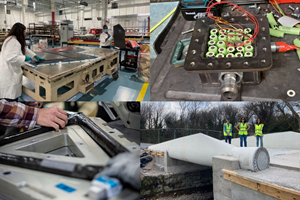Gearing up for the new economic normal
In late July, as my family and I raced home from our vacation along Interstate 80 in northern Nevada, we found ourselves quickly overtaking a large flatbed tractor trailer. Strapped onto the bed and covered with a massive tarp was a very large … something, about 15 ft long and 8 ft in diameter.
In late July, as my family and I raced home from our vacation along Interstate 80 in northern Nevada, we found ourselves quickly overtaking a large flatbed tractor trailer. Strapped onto the bed and covered with a massive tarp was a very large … something, about 15 ft long and 8 ft in diameter. As we got closer, we could make out lettering printed on the heavy tarp: GEnx.
“Hey, look kids!” I exclaimed. “It’s the GEnx engine for the 787! It’s got carbon fiber fan blades and the first composite fan case on a commercial jet engine ….”
“Huh?” said my oldest son. “What’s it doing out here, and where’s it going? And how’s the plane going to fly without it?”
I explained to my rapt audience the most recent first-flight delay of the 787, announced in June, caused by greater-than-expected tension on the wing/fuselage interface on the plane — great enough to demand reinforcement of composite structures in the wings. And when we got home two days later, I received a press release from Boeing announcing that the GEnx engines had been sent to GE in Cincinnati, Ohio, for maintenance. They wouldn’t be powering a 787 for a while.
This was followed in August by the revelation from Jon Ostrower, author of the Flightblogger Web site, that Boeing had, in June, discovered a problem with 787 composite fuselage stringers produced at the Alenia facility in Italy. Out-of-spec stringers had, according to a Boeing letter obtained by Ostrower, caused unacceptable wrinkling in the laminate skins of some 787 fuselage shipsets. Boeing is reportedly working with Alenia on a fix for the affected structures.
The subsequent media lather, of course, makes an unschooled observer wonder if the 787 will ever leave the ground. A more reasoned assessment, keeping in mind past new-plane launches, tells a different story.
The fact is that any new aircraft, whether it is made of aluminum, composites or paper, encounters a variety of technical hurdles on the way to first flight — all hurdles that are eventually cleared. On a plane like the 787, making such extensive use of composites for the first time, it should be no surprise that Boeing is confronted with a host of foreseen and unforeseen technical challenges.
When these challenges come in bunches, as they have, it’s helpful to remind ourselves that this unique aircraft will in fact fly and will in fact perform as promised. It will enjoy years of service and will mark a turning point in commercial aviation materials use. It’s important to see past this turbulence in the run-up to first flight.
Similarly, it’s important now to start looking past the economic turbulence of the past year-plus. Reading the economic tea leaves in economic reports issued in early August, it appears that the worst of the recession is behind us — at least the not-as-bad news outnumbers the outright bad news these days. Some prognosticators have gone so far as to suggest that the third quarter of 2009 may show actual GDP growth in the U.S. Even General Motors is calling back laid-off workers and authorizing overtime once again.
This apparent recovery won’t be confirmed, of course, for several months, and it’s hard right now to take joy in the potential of a resurgent economy when income and employment remain sluggish. It must be understood, however, that this economy will perform again, and we are closer to recovery now than we were six months ago. The question is, Will all of us be positioned to take advantage of the new economic normal, when it arrives? It’s time to start thinking proactively and getting geared up to be a part of it.
I hope to see you there.
Related Content
The return of trade show season
SAMPE Seattle, JEC World and the Paris Air Show are approaching fast, and they signal the real emergence of a post-pandemic world.
Read MoreRemembering Don Adams
When one thinks of composites test methods, one thinks of Don Adams. Don passed away at the end of 2022. We remember him here.
Read MoreUp, not out: The next chapter of CompositesWorld
I have been editor-in-chief of CompositesWorld for 17 years, which translates into a lot of editorials. This will be my last as I become publisher of CW. We welcome Scott Francis back to the brand to take my place.
Read MoreAs 2023 begins, a look back at trending CW topics in 2022
With 2022 now behind us, CW’s editor-in-chief Jeff Sloan takes a look at the CW stories last year that received the most reader attention.
Read MoreRead Next
CW’s 2024 Top Shops survey offers new approach to benchmarking
Respondents that complete the survey by April 30, 2024, have the chance to be recognized as an honoree.
Read MoreFrom the CW Archives: The tale of the thermoplastic cryotank
In 2006, guest columnist Bob Hartunian related the story of his efforts two decades prior, while at McDonnell Douglas, to develop a thermoplastic composite crytank for hydrogen storage. He learned a lot of lessons.
Read MoreComposites end markets: Energy (2024)
Composites are used widely in oil/gas, wind and other renewable energy applications. Despite market challenges, growth potential and innovation for composites continue.
Read More


























